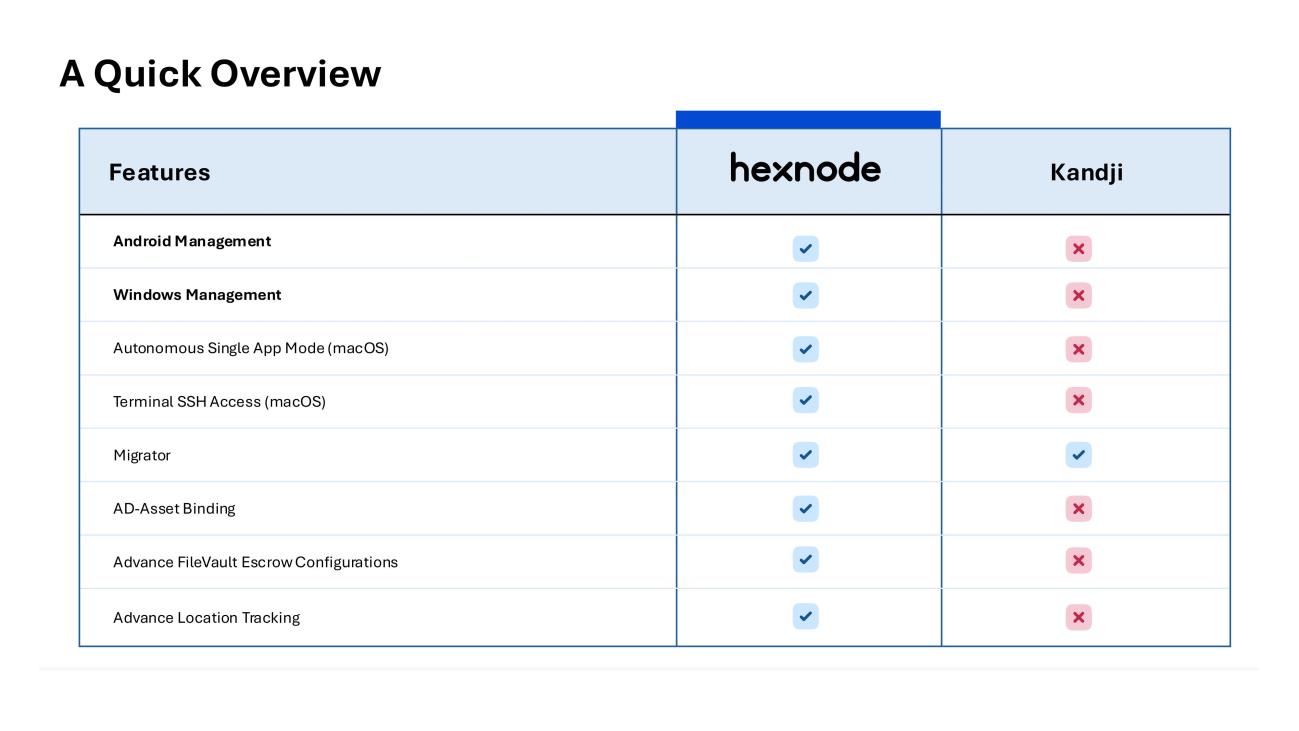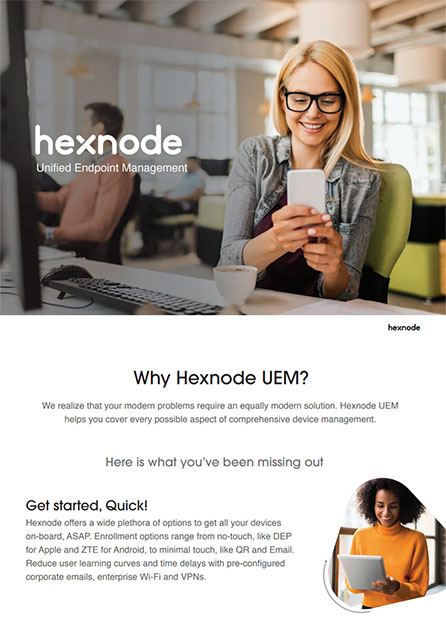Why organizations choose Hexnode UEM to manage Apple devices?
Hexnode UEM simplifies Apple device management by offering easy deployment, strong security, and seamless integration.

Get fresh insights, pro tips, and thought starters–only the best of posts for you.

Choosing a device management solution is a bit like picking the perfect tool for a big project. You need something powerful, reliable, and, most importantly, right for your specific needs. If you’re managing a fleet of Apple devices, you’ve likely to come across two strong contenders: Hexnode and Kandji.
This blog post provides a detailed Hexnode vs Kandji comparison to help you decide. Both platforms are champions in the Apple device management space, but they approach the task from different perspectives. Kandji has built its reputation on being a refined, Apple-exclusive powerhouse. We at Hexnode, on the other hand, love Apple devices just as much, but we also believe in a world where Macs, iPhones, and iPads can coexist harmoniously with Windows, Android, and more, all under one roof.
So, let’s take a friendly stroll through what makes each solution unique and help you figure out which one fits your organization’s puzzle perfectly.
Hexnode: We’re a Unified Endpoint Management (UEM) solution. Think of us as the universal remote for all your company’s devices. Whether your team uses MacBooks for design, Windows PCs for admin tasks, iPhones on the go, or Android tablets in the field, Hexnode brings them all together into a single, easy-to-manage console. Our goal is to provide deep, comprehensive management capabilities across every major operating system.
Kandji: Kandji is a dedicated Apple device management (MDM) platform. It’s built from the ground up with a singular focus: to manage and secure macOS, iOS, iPadOS, and tvOS devices. This laser-focus allows Kandji to offer a highly polished and intuitive experience specifically tailored for businesses that operate exclusively within the Apple ecosystem.
| Aspect | Hexnode | Kandji |
| Supported Platforms | macOS, iOS, tvOS, Windows, Android, Fire OS, Chrome OS, Linux, Vision OS | macOS, iOS, iPadOS, tvOS, Vision OS |
| Best For | Mixed-device environments or businesses planning for future platform diversity. | All-Apple businesses seeking a streamlined, Apple-centric experience. |
Beyond the operating systems, the specific features of a UEM solution are what truly empower IT teams.
In the Hexnode vs Kandji debate, feature sets are a major differentiator.Hexnode offers a range of advanced functionalities that are not always available in more specialized solutions.
Here are a few features where Hexnode stands out:
Comprehensive Management: Hexnode provides robust management for both Android and Windows devices, a crucial feature for organizations that are not exclusively Apple-based.
Advanced macOS Functionality: For macOS, Hexnode offers features like Autonomous Single App Mode and Terminal SSH Access, giving administrators more granular control over their devices.
Seamless Migration: Hexnode supports migration, which helps you seamlessly transition from your existing MDM solution.
Enhanced Security: With features like AD-Asset Binding and Advance FileVault Escrow Configurations, Hexnode provides an extra layer of security for your endpoints.
Location Tracking: Hexnode also offers advanced location tracking capabilities, which can be invaluable for asset management and security.
Automation and Compliance: Hexnode enables IT teams to automate routine tasks and enforce compliance effortlessly. With dynamic device grouping, custom scripts, and automated policy enforcement, administrators can streamline workflows and ensure devices stay secure and policy-compliant without manual intervention.
Likewise, Kandji brings its own set of innovative features to the table, showcasing its deep focus on streamlining the Apple admin experience. Here are a few areas where Kandji’s specialized approach shines:
Auto-Apps Library: Kandji’s Auto-Apps library is a standout for busy IT teams. It’s a curated collection of third-party macOS applications that Kandji pre-packages, hosts, and automatically patches for you.
Liftoff Onboarding: It works with Apple’s Automated Device Enrollment to ensure all necessary apps and configurations are installed before the user gets to the desktop, guaranteeing a fully provisioned device from the very first login.
Blueprints and Assignment Maps: Kandji’s core configuration is built around “Blueprints” – templates that contain all the apps, controls, and settings for a group of devices. Their Assignment Maps provide a clear, visual way to see how these Blueprints are assigned across the fleet, simplifying the management of different user roles and departments.

A powerful tool is only as good as its user experience.
Here’s what one user had to say about their Hexnode experience:
“One word to describe my whole experience is: Easy. Hexnode made it super simple for the small bank I work at to enroll devices……. Their support is two clicks away, which is always nice for when I have simple questions…… The layout of the portal as well as knowledge articles….. are clear, easy to navigate, and even easier to ask for support.”
Source: Capterra
Mitsogo (Hexnode) Recognized in the 2025 Gartner® Market Guide for Endpoint Management Tools
Kandji also delivers a clean and polished interface tailored for Apple environments. However, some users have noted limitations when it comes to customization and configuration flexibility.
“We need to depend on third-party applications to create the configuration profiles. I want the team to build some general in-built configuration profile settings to configure within MDM.”
“Some advanced configurations feel limited or require workarounds, especially for edge-case device policies. Reporting can also feel a bit basic if you’re looking for deeper insights or custom metrics.”
Source: Capterra
While Kandji excels in delivering a refined Apple-centric experience, these reviews highlight areas where organizations with more complex or evolving needs might find Hexnode’s broader customization and reporting capabilities more suitable.

Hexnode offers a powerful suite of features to get all your devices on board and make them work-ready. Download the brochure to learn how Hexnode is the right solution for modern-day enterprise mobility problems.
Download BrochureAt Hexnode, we pride ourselves on our customer-centric approach. Our dedicated support team is available 24/5 to assist you with any questions or concerns. We also offer a comprehensive library of help documentation, video tutorials, and an AI-powered chatbot to help you find the answers you need.
Transparency in pricing is important for budgeting and planning.
Hexnode: We believe in flexible, transparent pricing that scales with your needs. Our pricing is tiered based on the features you require, starting from the very basics to the full UEM suite. We charge per device, per month, and support for all platforms is included in the price. This allows businesses of all sizes to find a plan that fits their budget without paying for features they don’t use. You can find our detailed pricing on our website.
Kandji: Kandji’s pricing is also customized to the customer’s needs. They typically provide a custom quote based on the number of devices you intend to manage. It’s best to reach out to their sales team for specific pricing details for your organization.
To give you an idea of the value Hexnode delivers, try our ROI Calculator to estimate the potential return on investment for your business.
Let’s simplify it.
You might be a perfect fit for Kandji if:
You’ll feel right at home with Hexnode if:
Take the case of a mid-sized logistics company operating across multiple regions. Their field teams rely on Android tablets for real-time inventory tracking, office staff use Windows PCs for administrative operations, and the creative teams prefer MacBooks for design and marketing tasks. Managing this heterogeneous device fleet will be increasingly complex, especially with varying OS-specific policies, app deployment needs, and compliance requirements.
If they adopt Hexnode, the IT team can centralize device management through a unified UEM console. They can leverage Android Enterprise for secure app distribution, use Windows policy enforcement to restrict access to sensitive settings, and deploy Apple’s ADE and VPP through Hexnode to automate iOS device enrollment and silent app installations. With dynamic grouping, they can apply platform-specific policies automatically based on device type and user role.
Choosing the right MDM often means getting straight answers to specific questions. Here are a few things we often see people asking when comparing solutions:
Is Hexnode a good choice if we’re a mostly-Apple company but have a few Windows PCs?
Absolutely! This is precisely where Hexnode shines. While Kandji is built for an exclusively Apple world, we’re designed for the reality of today’s workplaces. You get deep, secure management for your Apple devices, but with the added power to manage those Windows, Android, and even Linux devices all from one place. No need for a separate solution or a complicated setup.
I’ve heard Kandji is really simple to use for Apple devices. Is Hexnode’s dashboard more complex because it manages more platforms?
Our UI is built to be simple and easy to navigate for all admins, regardless of their experience. The goal is to make managing a diverse fleet just as intuitive as managing a single platform. We believe the key to a great user experience isn’t about limiting what you can manage, but about making comprehensive management effortless. Our customers often mention how quickly they get up and running, even with a mix of operating systems.
Does Hexnode offer the same level of security for macOS as Kandji?
Yes, and we take it very seriously. Hexnode provides robust macOS security features like FileVault encryption management, security policy enforcement, and Terminal SSH Access. We also offer advanced features like AD-Asset Binding to enhance security in a mixed environment.
What about the cost? Is a UEM like Hexnode more expensive than a dedicated Apple MDM?
Not necessarily. Our transparent, tiered pricing allows you to choose a plan that fits your specific needs and budget. We charge per device, not in large bundles, which can often make us a more cost-effective solution for small to mid-sized businesses, especially as they scale. It’s all about providing a flexible solution without the hidden costs or licensing minimums.
At Hexnode, we’re incredibly proud of our Apple management capabilities. We offer the depth and security you need to manage your Apple fleet with confidence, combined with the power and flexibility to manage everything else, too.
This makes the Hexnode vs Kandji decision clearer for businesses that value flexibility.
Why limit yourself? The modern workplace is diverse. Give your IT team the single tool they need to manage it all.
Experience the power of a true Unified Endpoint Management solution. Manage every device, from anywhere.
Explore Hexnode Now